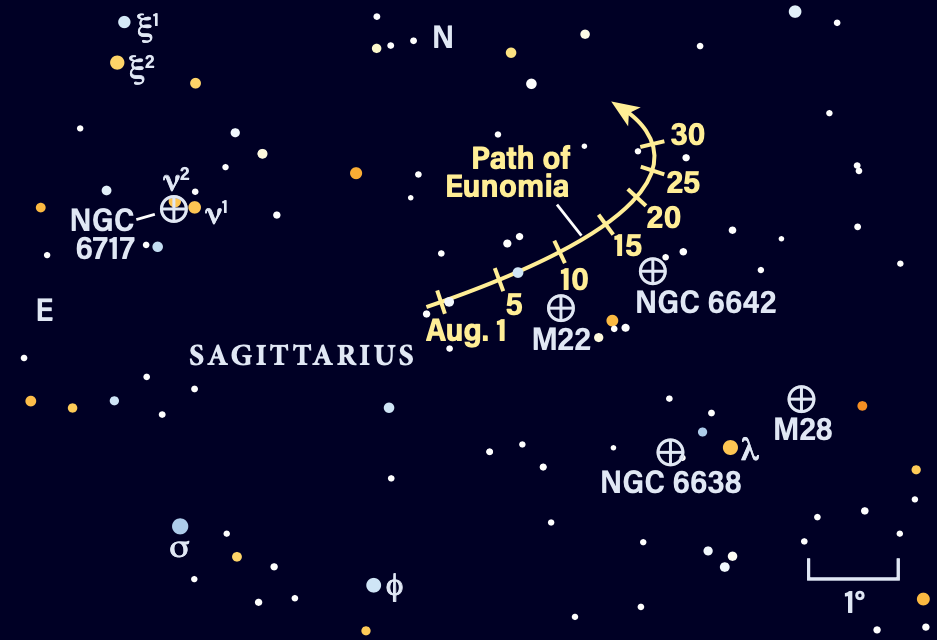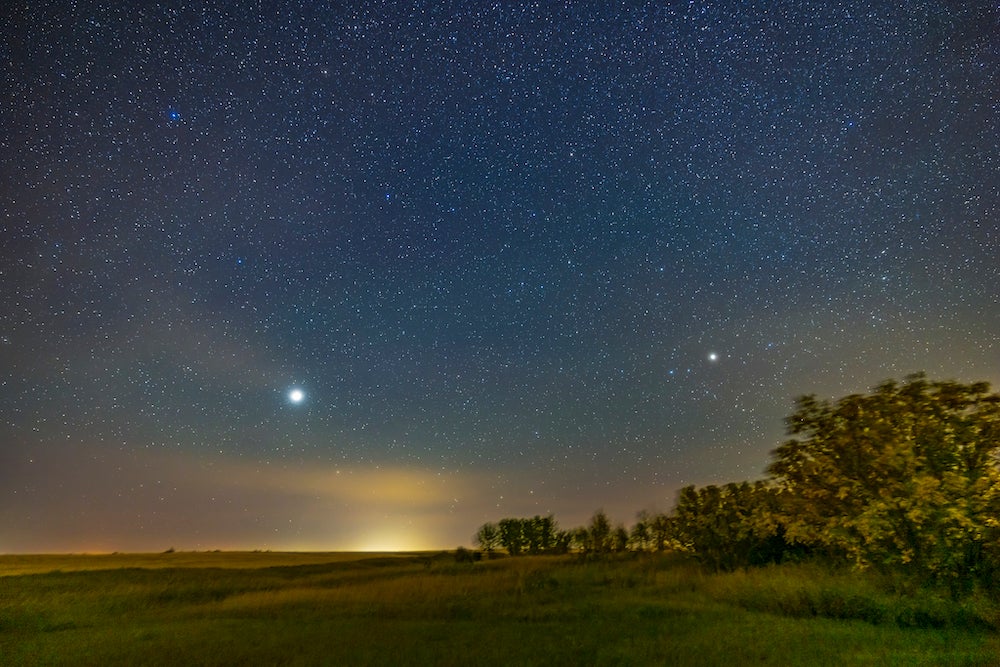
The gas giants reign as spectacular objects overnight; their moons also attract attention. Our evening sky has a rapidly diminishing view of Mercury, with Mars difficult to spot. Morning carries Uranus and Neptune, easily viewed in binoculars. And in the second half of August, Venus returns as a brilliant object in the predawn sky.
Mars is challenging at magnitude 1.8 in the twilight sky, but you might get a glimpse on Aug. 18, when it stands 11/4° south of a waxing crescent Moon in the west after sunset. The pair sets just over an hour after the Sun and Mars becomes increasingly harder to spot as its altitude declines. Find the Moon first, then search for Mars.
On Aug. 1, Mercury stands 6° high in the western sky 30 minutes after sunset, shining at magnitude 0.1. The planet dims to magnitude 0.4 by Aug. 10 and is now 5° high half an hour after sunset. It’s nearly 5° lower than Mars, but the Red Planet is much fainter and less visible.
One day earlier, on the 9th, Mercury reaches greatest eastern elongation, when it stands 27° east of the Sun. However, the low angle of the ecliptic renders the planet difficult to see; it is more favorable for Southern Hemisphere observers. On the 18th, while you’re searching for Mars near the Moon, Mercury sits some 6° below our satellite. It’s very close to the horizon, too low to be easily seen.
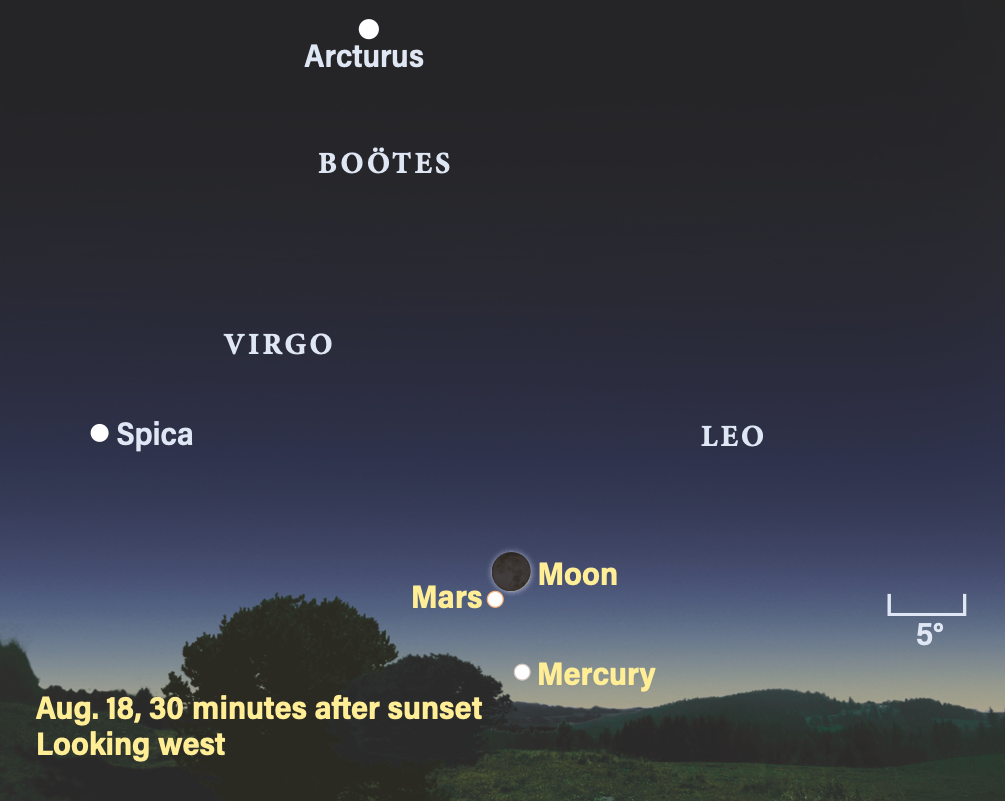
Saturn reaches opposition Aug. 27 and the ringed planet is visible from dusk to dawn. On Aug. 1, Saturn rises by 9:30 p.m. local daylight time and is well placed 25° above the southeastern horizon by midnight. It’s located in Aquarius the Water-bearer. The planet reaches its opposition magnitude of 0.4 by Aug. 16.
The night of Aug. 2/3, Saturn stands within 4° of a bright, nearly Full Moon. The Moon returns to Aquarius Aug. 30, when the two stand 6° apart a few hours after rising. Also near Saturn is the bright 1st-magnitude star Fomalhaut, located 20° southeast of the planet in Piscis Austrinus.
Telescopic views reveal the sunlit northern side of the rings, which are tilted earthward by 8° in early August. Their angle increases to 9° by the 31st. In just a few years, the rings will appear edge-on with only a small annual fluctuation. The disk of Saturn spans 19″ at opposition — pretty impressive when viewing it from a distance of 820 million miles. Saturn’s rings span 43″, more than double the disk’s width.
Experienced observers will look for the Seeliger effect, a brightening of the rings at opposition when the shadows of ring fragments are hidden from view as the illuminating Sun stands directly behind us. Observe the rings over a few nights around the 27th to see whether you notice the effect. You might also record Saturn photographically to create a permanent record.
Three separate rings are visible in small telescopes. The outer A ring is dusky. Under excellent conditions, its Encke Gap might be seen. A broader dark gap, the Cassini Division, is easily visible at the inner edge of the A ring. Interior to that is the brightest ring, the B ring. Darker and more ethereal than the A ring is the innermost C ring, also called the Crepe Ring for its diaphanous nature.
Orbiting Saturn in the same plane as the ring system is a collection of moons, many visible in small telescopes. Most obvious is Titan, which shines at magnitude 8.5. This moon’s atmosphere gives it a slightly yellowish hue. It stands north of the planet Aug. 7 and 23, and south Aug. 15 and 31.
Fainter moons orbit closer to the rings. At opposition, they’re at their brightest for the year. Rhea is brightest around magnitude 9.7, then Tethys around 10.3 and Dione at 10.5. Magnitude 11.9 Enceladus, which orbits every 33 hours, is challenging to see due to Saturn’s brilliance. This icy moon sports active geysers near its southern pole.
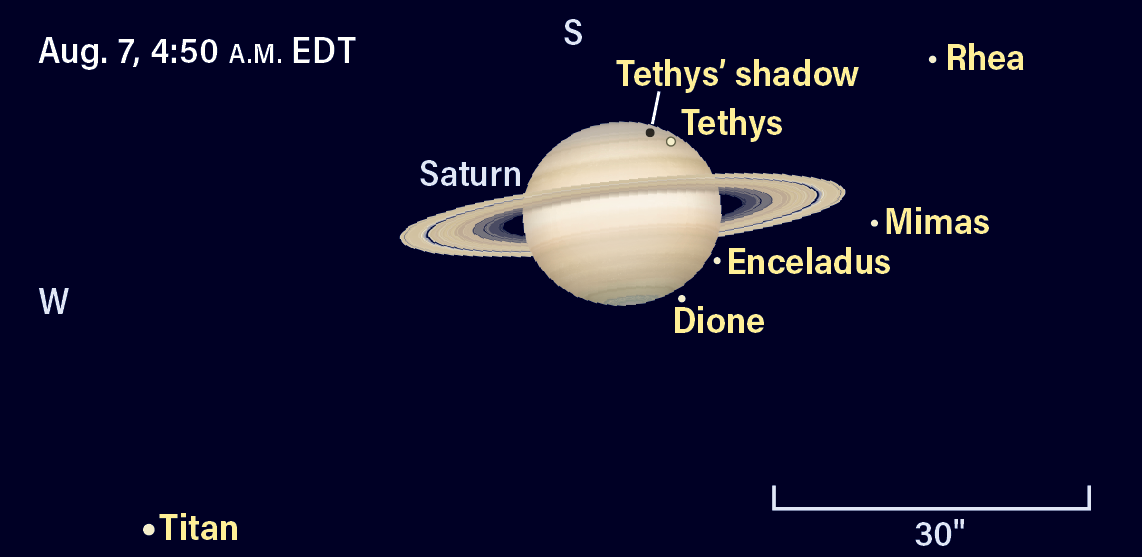
Thanks to their orbital tilt, the moons now undergo transits and occultations with Saturn. Such events are more difficult to observe than their jovian counterparts due to the larger contrast between Saturn and its moons. For a challenge, see if you can spot Dione as it’s occulted by Saturn on the morning of Aug. 7, when it skims the northern limb of the planet between approximately 3:15 a.m. and 4:45 a.m. EDT.
Exceedingly difficult is the reappearance of 12th-magnitude Enceladus from behind Saturn the same morning at 4:41 a.m. EDT, reappearing off the planet’s northeastern limb. Meanwhile, a third event is occurring south of the rings. Tethys and its shadow begin a transit, starting with the shadow just before 4:40 a.m. EDT. The moon follows six minutes later. Many similar events will occur quite regularly now, given these moons’ short orbital periods.
Iapetus lies far from Saturn, orbiting every 79 days. It reaches eastern elongation Aug. 1, standing 9′ east of the planet. It’s magnitude 11.9, with its darker hemisphere facing Earth. Iapetus brightens through the month; track it as it reaches inferior conjunction Aug. 20 at midnight EDT, just 25″ northwest of Saturn and shining near 11th magnitude. The following night, it’s already skipped nearly a full arcminute away, brightening as it goes. Iapetus reaches western elongation next month at magnitude 10.2.
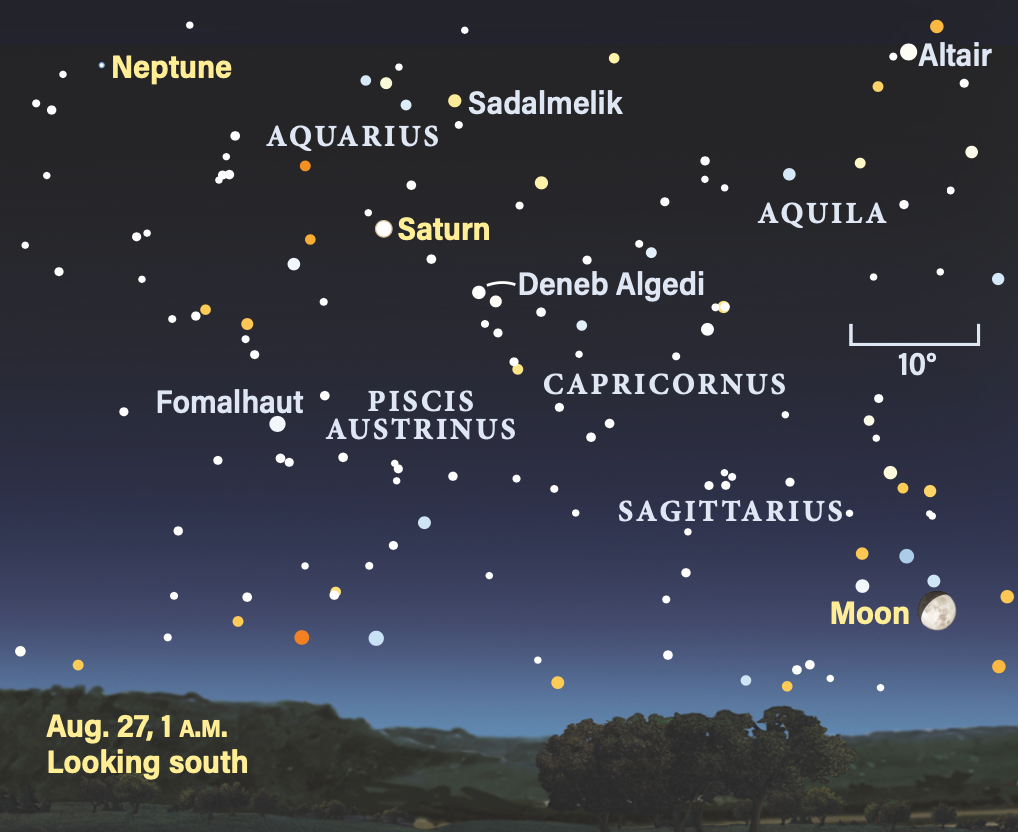
Neptune rises just after 10 p.m. local daylight time on Aug. 1 and before 8:30 p.m. on Aug. 31. This brings it into the evening sky not far from the Circlet of Pisces. At magnitude 7.7, the planet is easy to confuse with the background stars, but its location just northwest of a line of three stars — 6th-magnitude 20 and 24 Piscium, and 5th-magnitude 27 Psc — aids with identification. You can find this trio of stars 5.6° southeast of Lambda (λ) Psc, the southeasternmost star in the Circlet. Can you spot Neptune’s tiny, bluish 2″-wide disk through a telescope? It will depend on seeing conditions.
As August opens, Neptune forms an equilateral triangle with 20 and 24 Psc. From night to night, the planet tracks southwest toward 20 Psc, ending the month 19′ from the star. Get familiar with this star — during next month’s opposition, Neptune gets much closer!
Jupiter rises shortly after midnight on Aug. 1 and is best placed for observing in the hours before dawn, when it stands more than 40° above the eastern horizon. It is in Aries the Ram and shines vividly at magnitude –2.4 in early August. On the morning of Aug. 8, Jupiter is less than 2.5° from a Last Quarter Moon. Note the Pleiades (M45) in Taurus, some 16° to Jupiter’s northeast.
Swing binoculars toward the gas giant and hold very steady — you’ll likely spot a few bright moons. Step up to a telescope to truly reveal the jovian system of four Galilean moons and a planet replete with light and dark cloud bands. Note the evident pair of belts straddling the equator. More subtle belts reside at northerly and southerly latitudes. Jupiter’s fast rotation — just under 10 hours — carries cloud features, including the Great Red Spot, across the disk. Their movement is noticeable to an attentive observer within 10 to 15 minutes.
The Galilean moons orbit roughly every two to 17 days. Their changing relative positions are fascinating to watch, as are transits and occultations.
The morning of Aug. 3, Io’s shadow falls on the jovian cloud tops at 4:45 a.m. EDT, followed by the moon itself at 5:07 a.m. CDT (right around sunrise on the East Coast). Europa follows suit midmonth. Its shadow begins a transit at 3:23 a.m. EDT on Aug. 14, followed by the moon at 5:12 a.m. CDT. Notice the longer gap between the transits of shadow and moon for Europa compared with Io — the latter has a smaller orbit.
Ganymede plays hide-and-seek for 77 minutes near Jupiter’s north pole Aug. 13. The shallow angle of the limb slowly hides the moon around 5:33 a.m. EDT — you’ll notice Ganymede dimming a few minutes before this. The large moon may appear to blend with the limb of Jupiter quite a bit earlier, depending on your seeing conditions. Ganymede reappears by 5:51 a.m. CDT, but be on the lookout earlier, again because it may reappear sooner.
Ganymede transits the south polar regions for an hour the morning of Aug. 31, from 3:26 a.m. to 4:27 a.m. EDT.
Note that the 5th-magnitude star Sigma (σ) Arietis lies close to Jupiter the last two weeks of the month, coming within an arcminute or two of the planet Aug. 21 and 22. Don’t confuse the star with the moons — they’re of similar brilliance.
Uranus stands between 7.5° and 9° northeast of Jupiter during August. It also lies in Aries and is a binocular object at magnitude 5.8. Uranus is best viewed in the hour before dawn, when it is 60° high in the southeast and roughly level with the Pleiades. Few other stars are nearby — the brightest are 4th-magnitude Delta (δ) and 5th-magnitude Zeta (ζ) Arietis, which stand 1.5° apart to Uranus’ northwest. East of them is 63 Ari, a bit brighter than Uranus, which lies 2.6° south of this star. Uranus wanders slowly east and slows to a stop late on Aug. 28, then begins its retrograde motion. A telescope will show a 4″-wide disk with a greenish hue.
Venus passes inferior conjunction Aug. 13 and quickly springs into the morning sky as a bright object nearly 4° high 30 minutes before sunrise on Aug. 21. By the end of August, Venus is 26.5° west of the Sun and almost 10° high among the dim stars of Cancer about an hour before sunrise. A telescope will show a beautiful 11-percent-lit crescent spanning 50″.
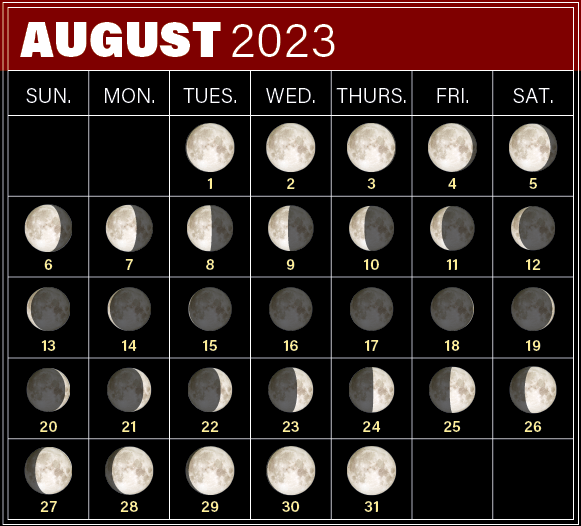
Rising Moon: Young and old together
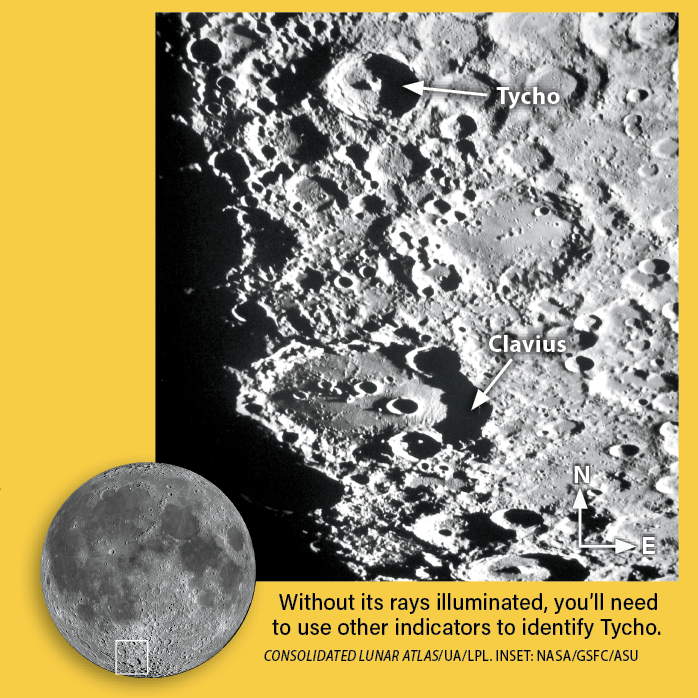
Tycho and Clavius are two longtime favorites of selenophiles. The duo stands out in the Moon’s southern half in a magnificent play of light and shadow when the Sun rises over them on the 24th. Under a low Sun angle, Tycho’s normally brilliant ray system is largely hidden from view. (It’s best seen a few nights from now.) But there are enough hints pointing back to it. A different giveaway to its identity are the signs of its youth: a prominent deep bowl, sharp rim, and well-defined central peak. The vast majority of objects in the crater-crowded southern highlands are anything but young.
Clavius is the huge feature closer to the limb. Its debris-filled floor and softer rim are the telltale consequence of age-old battering by smaller impacts at the end of the solar system’s period of heavy bombardment. Take a closer look inside the shallow bowl to see a neat curving chain of impact features. Over the course of an hour, track the shadows’ retreat and spy the appearance of even smaller craters.
In the following nights, Tycho’s rays become increasingly obvious. Also note the darker ring around its raised rim. The heat from the blast that formed it caused the surrounding surface to partially melt and lose its lighter shade. While Clavius never gets lost because it is so big and distinct, average-sized craters nearby that were obvious on the 24th are now practically unidentifiable amongst dozens of divots.
The region can be viewed under reverse lighting at 5 a.m. on the 7th and 8th, when the Moon is high in the south.
Meteor Watch: Perseid prospects
The Perseid meteor shower, one of the year’s best, peaks Aug. 13 with expected rates exceeding one per minute in the hour before dawn, even as a slender 8-percent-lit crescent Moon hangs in Gemini. This year is one of the more favorable times for North American observers, with the predicted peak starting around 3 a.m. EDT.
The best place to look for Perseids is typically at 45° altitude some 40° to 70° away from the radiant. A favorite constellation to watch during the Perseids is Cygnus, as many shower members run its length.
The shower is active from July 17 through Aug. 24. Around these dates the rates are very low, rising to a peak in the second week of August. The expected zenithal hourly rate on Aug. 13 is 100 meteors per hour. In the hour before dawn, Perseus is about 60° high, so expect a rate closer to 50 or 60 per hour at peak for North American observers (as the altitude of the radiant strongly affects the observable rate).
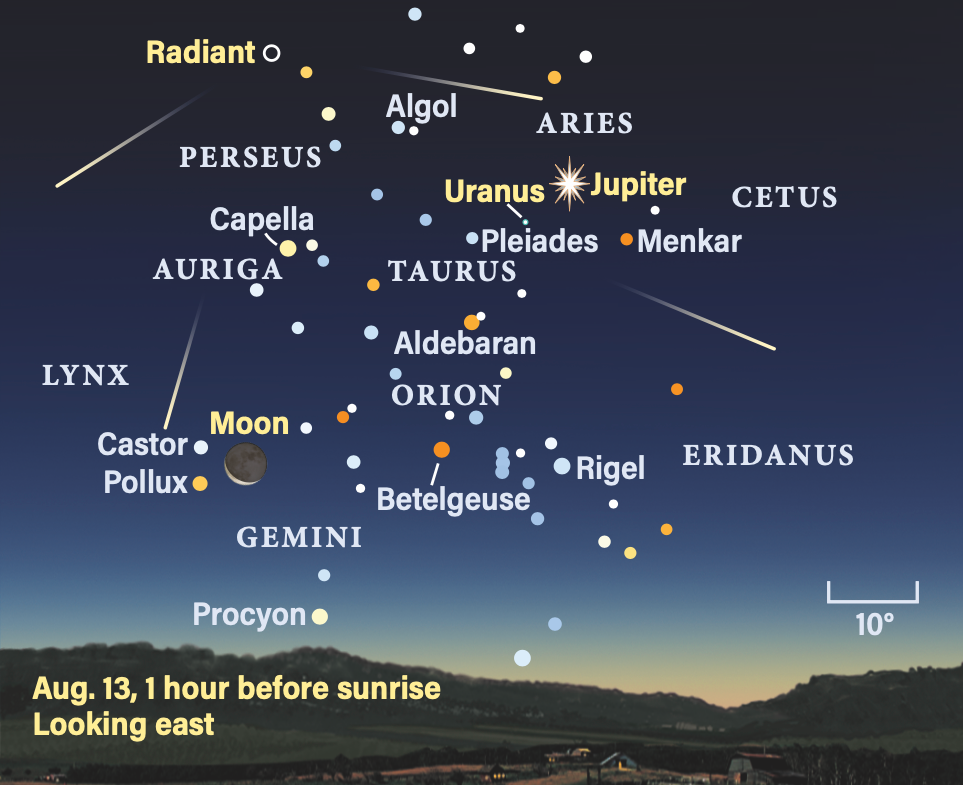
Comet Search: Location, location, timing
Finally! An extended period of decent comets begins, and we even have choices. Don’t dally if you want to catch C/2021 T4 (Lemmon). Tracking northward into Libra, this 8th-magnitude fuzzball from the Oort Cloud is fading after its closest approach to the Sun July 31. Compare it with globular clusters such as the concentrated NGC 6144 near Antares, then diffuse NGC 5897. Because Lemmon is already setting in the southwest as it gets dark, be ready at the start of your observing session.
Better suited for late arrivals at the dark site is short-period (6.5 years) 103P/Hartley 2. Glowing a modest magnitude 10, Hartley slides from head to toe in Andromeda as it rises higher with each hour of the night. By midmonth, the comet is a second Ghost of Mirach, passing by Beta (β) Andromedae not far from the galaxy NGC 404. This object can catch imagers unawares, posing as an internal lens reflection of the bright star. The green glow of diatomic carbon around the comet’s coma should make for a nice contrast with the gray smudge of the galaxy.
Despite the nearly Full Moon, catch Hartley 2 on the 31st when it is less than a degree from M34, a nice star cluster in Perseus.
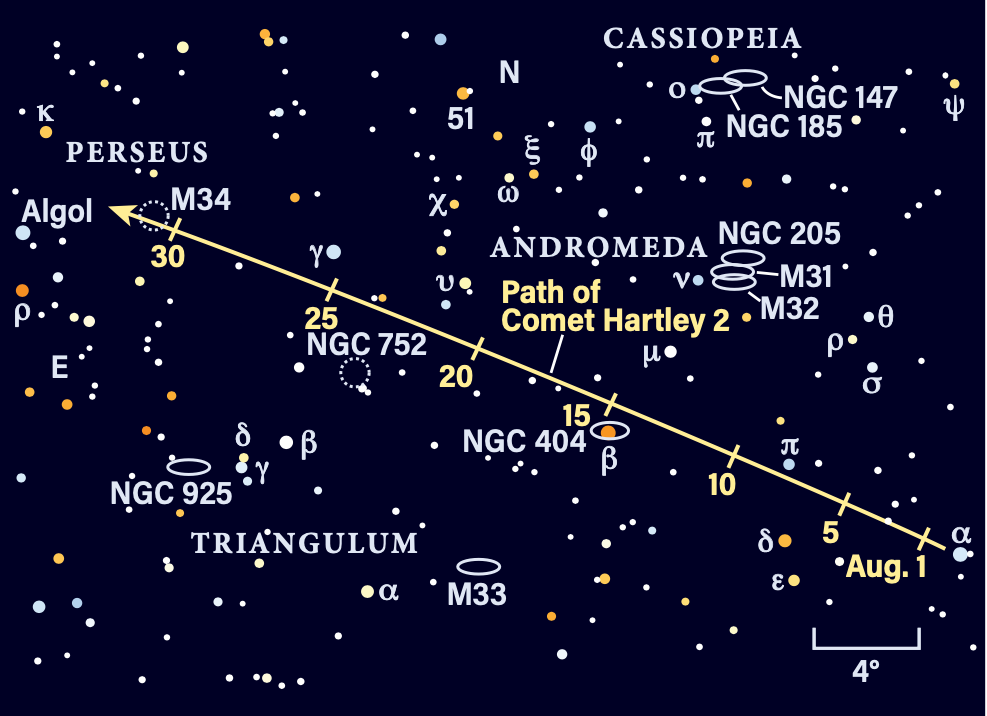
Locating Asteroids: A familiar place
If you don’t know where M22 is, find out and return year after year. Located about 2.5° northeast of the tip of Sagittarius’ Teapot (in the south for most readers), this massive globular cluster is an easy find in binoculars from a rural sky. M22 is our anchor point for an all-month stakeout of main-belt asteroid 15 Eunomia.
Thanks to the many dark dust lanes crossing the front of our Milky Way’s core, magnitude 9 Eunomia won’t be lost among throngs of more distant stars. On the other hand, its apparent motion is on the slow side, so we’ll want to make a sketch of a star field and come back a night or two later to see which dot has moved. The 1st to the 2nd and especially the 6th through the 8th are the best opportunities. During the last third of August, Eunomia is almost the brightest dot in its region.
Discovered in 1851 by Annibale de Gasparis, the potato-shaped boulder spans a respectable 220 miles end to end and 130 miles across the middle, putting it among the top 10 largest bodies in the main belt. It appears to be the parent of an associated asteroid family formed by a collision long ago. Named for the mythological Greek personification of law and order, Eunomia was among the evidence used to demote asteroids to their own group from their original status as planets.
